Understanding Asset Allocation
July 26, 2023|Kurtis Thompson

Bottom Line Up Front
- This article provides an overview of the different financial asset classes, including Domestic Equities, International Equities, Fixed Income, Alternatives, and Real Estate.
- Each asset class has its own characteristics and risk profiles. Domestic Equities vary in size and growth potential, while International Equities involve currency exchange risk. Fixed Income offers predictable payments, while Alternatives encompass a diverse range of investment types and Real Estate includes rental properties, REITs, and raw land.
- Understanding each asset class can help you make informed investment decisions and create a diversified portfolio based on your risk tolerance and investment goals.
From pension plans, OPEB plans, 401(k) plans, or personal investments many people are faced with the dilemma of understanding various types of financial assets. This article will help you start to understand what these asset classes are and some of their basic characteristics.
You can also check out our on-demand webinar on this topic as well: Understanding Asset Allocation
What is Market Capitalization?
Conversations about asset allocation will almost always contain terms like Market Cap, Large Cap, Small/Mid Cap, etc. I’ve had several conversations where people ask, “Why are Markets or Equities capped?” Whenever you see the word “Cap” in terms of asset allocation we aren’t talking about a maximum limit on assets, the term “Cap” is short for Capitalization. Market Capitalization means the total value of a company on a financial market. The formula for calculating the market capitalization of a company is the number of shares outstanding x the cost per share of that company. For example, the Market capitalization of Coca-cola:
- Number of shares outstanding – 4.3 billion
- Cost per share assumed – $60.00
- Market capitalization – 4.3 billion x 60 = $260 billion
Domestic Equity – Large Cap
Our first asset class is “Domestic Equity – Large Cap”. Domestic Equity means that this is a U.S.-based company and Equity means we are talking about their stock or ownership shares of the company. Large Cap means the market capitalization of these companies is “Large”. Large-cap is not a single definition, different professionals will have differing opinions on what classifies a company as “Large”. In general, a market cap of about $10 billion is considered large. Large companies are more likely to be household names as well. Some that you’ve probably heard of are Apple, Microsoft, Amazon, Coca-Cola… and so on.
What are some characteristics of large-cap companies?
They tend to have at least nationwide business operations and there’s a very good chance they have large international operations as well. In general, there is less room for rapid growth for these companies. They don’t have many large untapped markets they can move their products to. On the inverse side, these companies tend to have more stable earnings than smaller companies, so they are less likely to have extreme losses in revenue.
All of that backdrop leads to a projected return (based on the 2022 Horizon Survey of Capital Market Assumptions) net of inflation of:
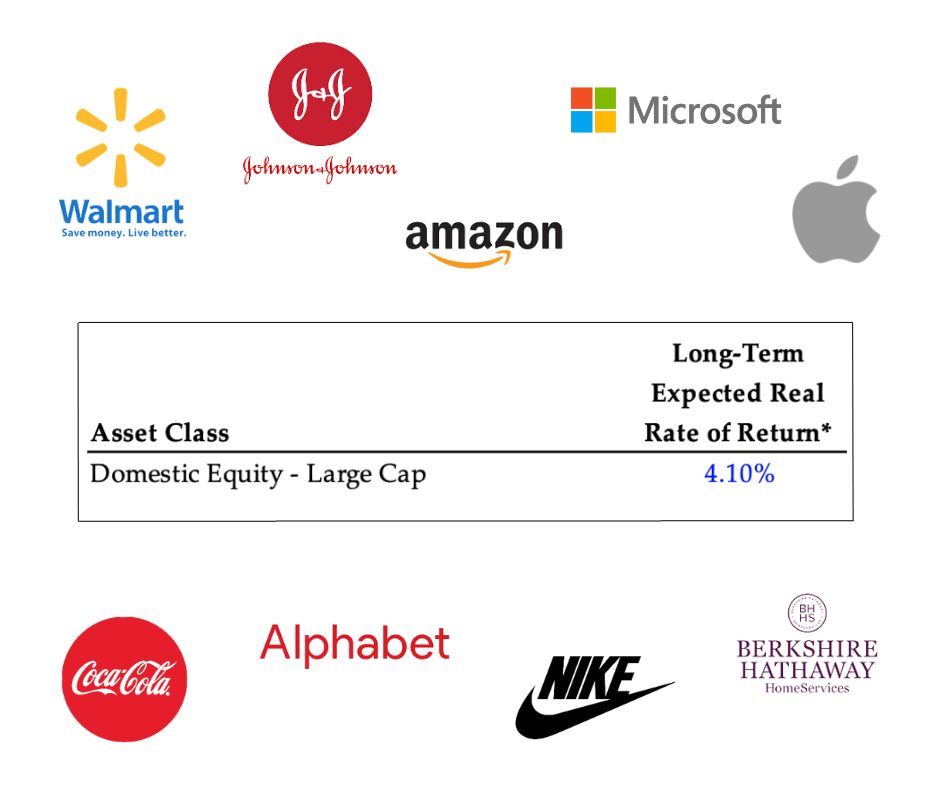
Domestic Equity – Mid Cap
The market capitalizations for Mid Cap companies will, again, not vary based on who you ask. However, some general guidelines include: Mid Cap companies have a market cap of $2-$10 billion. Many of these companies are still household names, although fewer are in the Large Cap category. Some Mid Cap companies you may recognize are: Yet, Hostess Brands, Harley Davidson, B.J.’s Wholesale, Crocs, and Texas Roadhouse.
Mid Cap companies compared with Large Cap companies will tend to have slightly more earnings and share price volatility. One way that is measured is with “Beta” (which will also be referred to with just the Green alphabet letter “β”). Beta measures the increased volatility of a stock or index compared to another index (generally the S&P 500). A Beta of 1.1 means that whenever the S&P moves 1% up or down the corresponding stock or index will move 1.1% up or down. Thus, a Beta above 1 means increased volatility. The Beta for a Mid Cap market index is 1.08 showing that in general Mid Cap companies are more volatile than Large Cap meaning higher potential gains and higher potential losses come with the Mid Cap territory.
While smaller than Large Cap, Mid Cap companies will still have large operations and are likely to be nationwide operations and may have some international operations as well. These companies may have more room for rapid growth if they can expand to new markets.
Domestic Equity – Small Cap
The market capitalization for Small Cap companies is generally considered to be $250 million – $2 Billion. As you start looking through Small Cap company index lists fewer of the names become recognizable household names for most people. Some names you may know are Ethan Allen and Winnebago.
Small Cap companies will tend to have even more earnings and price volatility with a Beta of 1.13, meaning these companies will tend to have even higher potential for outsized gains or outsized losses. These companies tend to have more regional operations and may have untapped markets that they could break into, rapidly expanding their market value.
The projected return for Small/Mid Cap companies net of inflation is:
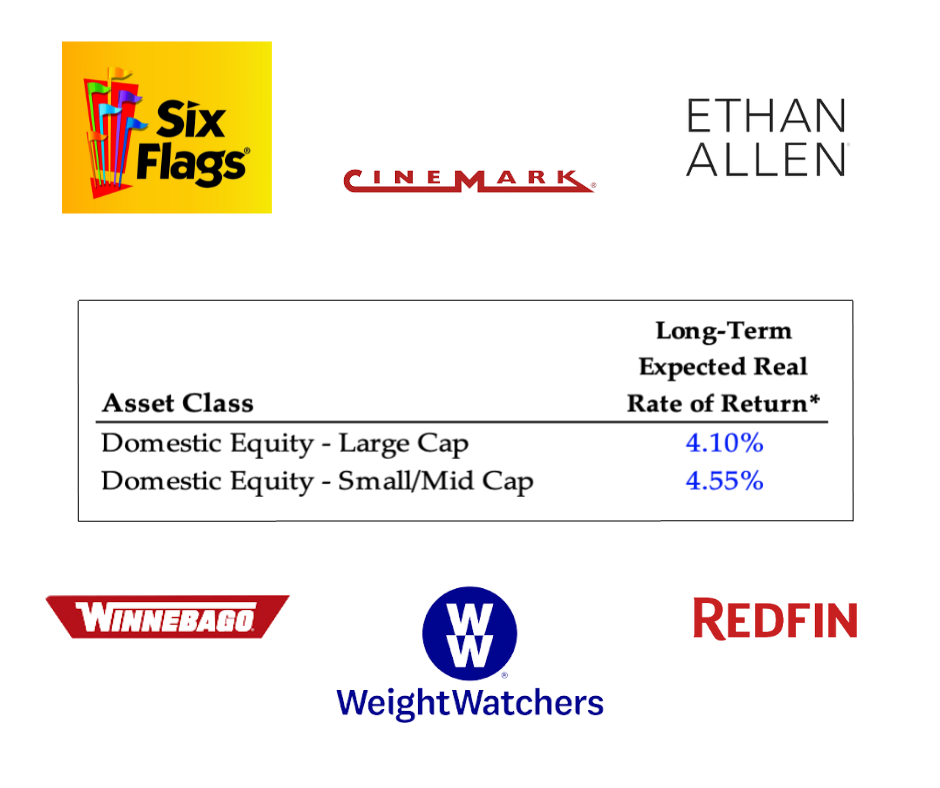
International Equity – Developed Market
International Equity, first off, is stock ownership in non-U.S.-based companies. Developed markets mean that these investments will be in areas that have developed economies and financial systems. Examples of Developed Markets include England, Ireland, Australia, Germany, France, and Japan.
International Developed companies tend to have low social and political risk. In other words, these governments and social frameworks are unlikely to create a scenario where a company experiences major changes to its business for social or political reasons. One risk that is introduced is currency exchange risk. Currency exchange risk is the variability that comes from the relative value change between local and foreign currencies. For example, if you bought shares in a U.K.-based company in pounds you had to exchange dollars for pounds to make the purchase, then when you go to sell the investment, you need to exchange the pounds back into dollars. Not only are you experiencing the risks associated with a business over that time period, but your investment can also change in value because the dollar becomes more or less valuable compared to the pound.
The projected return for International Developed companies net of inflation is:
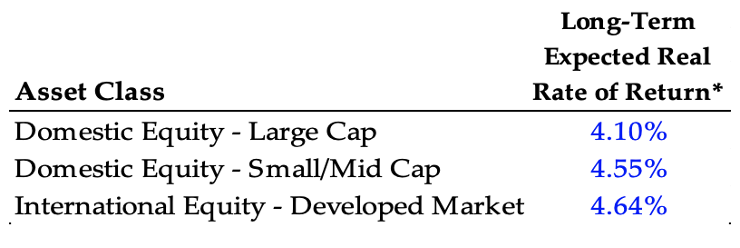
International Equity – Emerging Market
Emerging Markets are in countries that don’t have a long-established industrial and economic environment, but are on the path to being stable and established economies. Examples of emerging Markets include Brazil, Turkey, India, China, and South Africa.
These companies have a higher potential for political or social risk and currency exchange risk. The tradeoff is that there is potential for companies in these markets to experience very rapid growth through stabilizing social, political, or economic factors as well as lots of opportunity for companies to grow in undeveloped markets. The downside is that these companies have a higher risk of volatility and a higher risk of severe losses.
The projected return for International Emerging companies net of inflation is:
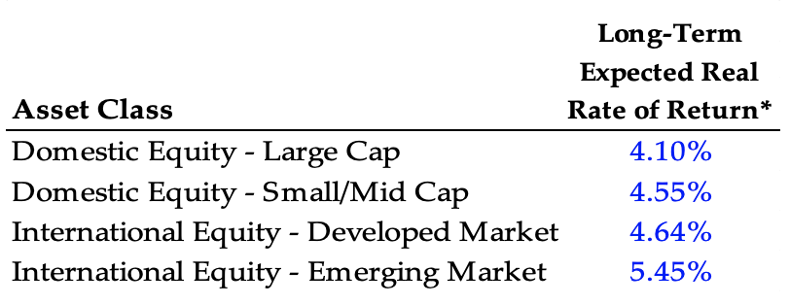
Fixed Income – Domestic and International
Our next class moves us away from the equities markets and into fixed income. Fixed-income securities have a fixed payment rate over the lifetime of the investment. Investments in this category include Bonds, Treasuries, CDs, and Preferred sales. All of these investments pay a fixed rate generally annually or semi-annually, over a certain time period. Domestic Fixed income invests in these investments in U.S.-based companies or municipalities.
There tends to be less risk in fixed-income investments because the payments to the investor are known rather than being based on the company’s performance like equity investments are. Fixed-income investors also tend to be paid first in the event of bankruptcy, so there is less risk of a total loss in the investment. Along with the decreased risk comes decreased expected returns.
International fixed income has the same characteristics but introduces currency exchange risk. There is also some diversification that comes from International fixed income as the “debt cycles” may be different for international companies and municipalities compared with the U.S.
The projected return for Domestic and International Fixed Income net of inflation is:
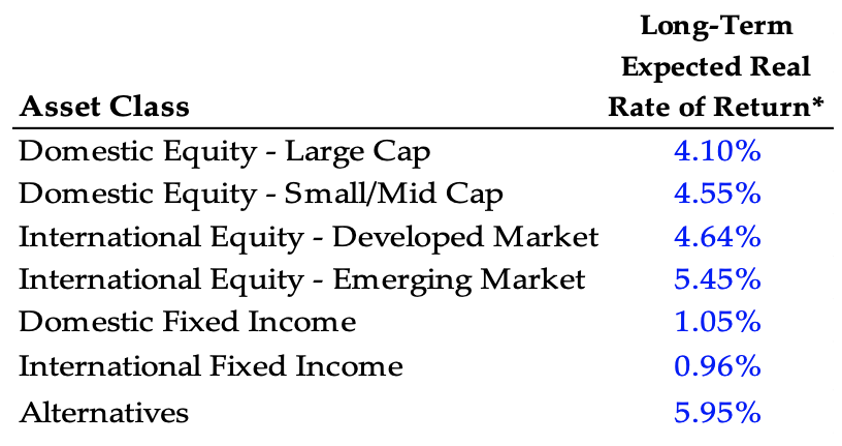
Alternatives
The next asset class to cover is Alternatives. This can be a tricky asset class because a lot of different investments are categorized as Alternatives. We’ll briefly go over some of the major Alternative investment types:
- Commodities – Metals, wood, animal or plant produce, oil, etc. Think gold, silver, and raw materials
- Adds diversification to a portfolio
- Hedge Funds – An investment vehicle that generally uses long and short positions to achieve a return in any market environment
- Can invest in anything
- Often have high expenses to cover active management
- Can use leverage
- Can limit liquidity
- Limited partnerships – Business structure often used to facilitate investments in private companies
- Access to non-publicly traded companies and business opportunities
- Low liquidity
- Private Equity – Invest in private businesses, often focused on buyouts or buying struggling businesses to turn them around
- Access to non-publicly traded companies and business opportunities
- Often use leverage to increase returns, also increasing risk
- Low liquidity
- Venture Capital – Invests mostly in startup companies that are not publicly traded with the goal of seeing a few become large publicly traded companies
- High potential returns and losses
- Low liquidity
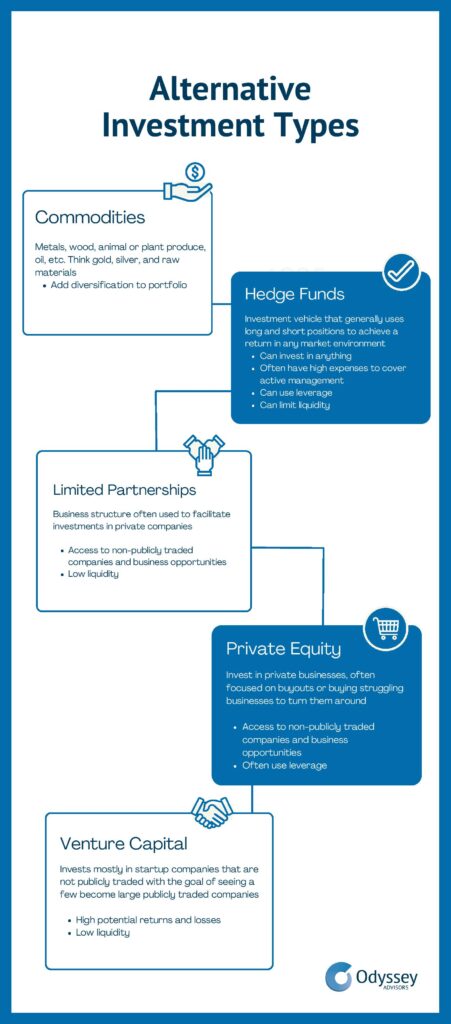
The projected return for Alternatives net of inflation is:

Interested in learning more? Check out our previously recorded webinar with Kathleen Glowacki on Demystifying the World of Alternative Investments
Real Estate
Real estate can be broken into categories, for this summary, we’ll break it into three categories: Rental Property, REITs, and Raw Land.
The projected return Real Estate net of inflation is:
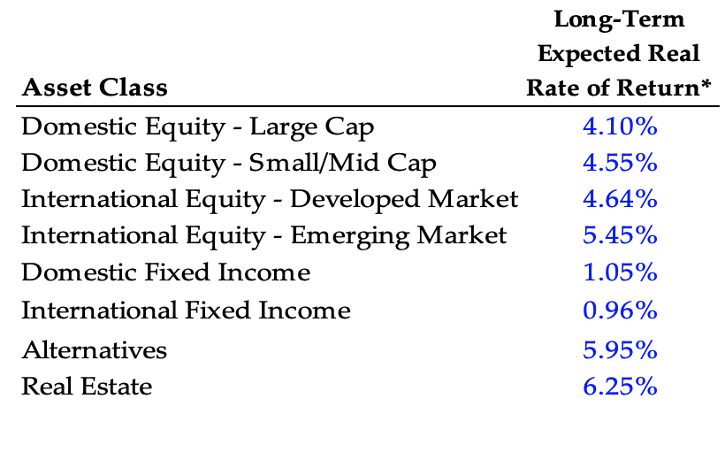
Putting all of these asset classes together we can create a hypothetical portfolio and show expected portfolio returns:

There is certainly much more that can be covered in the area of asset allocation. Hopefully, this has helped you get a better understanding of what various asset classes are and some of their characteristics. If you have any questions or if you have any asset allocation questions you’d like us to cover in another article, please let us know! You can reach us here.

About The Author Kurtis has been a consultant on the Odyssey Advisors team since 2013 and has developed extensive knowledge and expertise in developing and administering retirement benefit solutions. Kurtis is passionate about helping people achieve the retirement they’ve always dreamed of...
More Insights From This author








